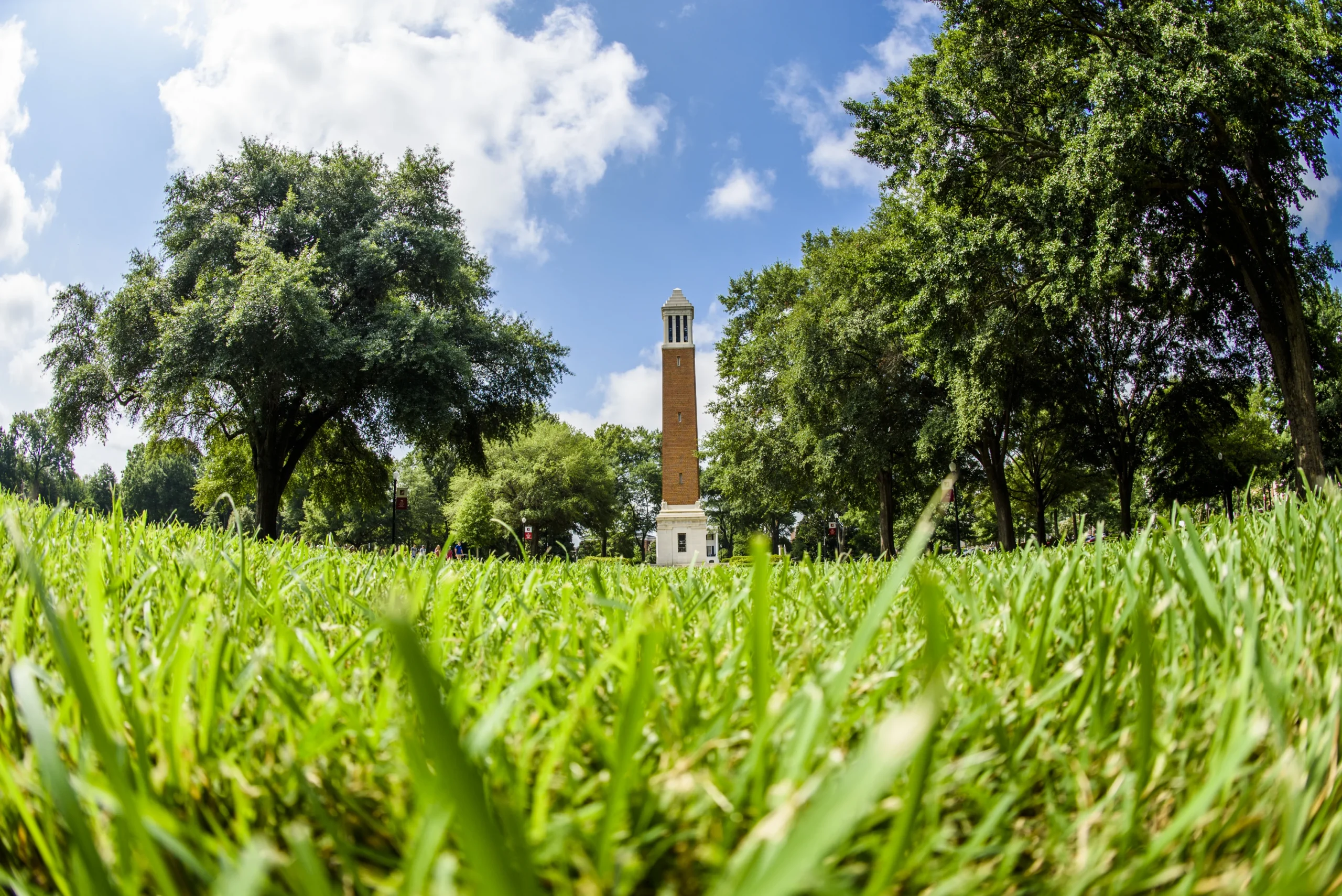1820
During the second session of the General Assembly, on December 18th, the “seminary of learning” is officially established and named The University of Alabama.
1844
The Normal Department is established. “The course of study will be substantially that of the regular college course, adapted to the varying conditions and wants of individuals, together with particular instruction in the art and business of a teacher.” According to President Manly in his report to the Board of Trustees on December 20th, “the faculty procured books and pamphlets relating to the subjects from the North and Europe, arranged a general course of study, and advertised that they would be ready to receive pupils in that department on the 22nd of April. . . .” No further mention of the Normal Department is made in the Catalogue until 1871.
1848
“It is ordained by the President and Trustees . . . that a department . . . is hereby created for the education of teachers of primary and preparatory schools in this state. The course of instruction . . . shall be regulated by the faculty until this Board shall otherwise direct. [A]s a prerequisite to admission each of such students shall file a declaration in writing . . . that it is his intention to prepare himself for a teacher and devote himself to that vocation in this state. [E]ach county in the state shall be authorized to send one student to the Normal Department free of charge for tuition; in other cases the price of tuition in that department shall be thirty dollars for the collegiate year.” Minutes, Board of Trustees, December 16, 1843
1871
For admission into the Normal Department, “the applicant must be at least sixteen years of age, and must pass a satisfactory examination on the elementary principles of Arithmetic, Geography, and English Grammar. The course of study requires three years for its completion.” The Catalogue (1871) notes that “Twenty-one students have entered this Department, beside others who have taken special studies therein.” The Normal Department is renamed the Normal School and located in the Department of Professional Education in 1873.
1899
The Normal School is reorganized as The School of Pedagogy and Psychology. The School is renamed The School of Psychology, Logic, and Pedagogy in 1901. History of Education and Methods of Teaching are added to the curriculum. In 1902 the School becomes the School of Philosophy and Education.
1903
James Harris Fitts (Class of ’49) of Tuscaloosa, an attorney and founder of what became the First Alabama Bank, establishes the first University scholarship by endowing $5,000. Recipients “must be, or propose to become, a teacher by profession. . . .”
1904
The first summer instruction at the Capstone, the Summer School for Teachers, begins during the summer months of 1904 with several hundred teachers, mostly from Alabama’s elementary schools. This Summer School is the precursor of the two-session summer school that the entire University now observes.
1909
Under the leadership of President John Abercrombie, Professor of School Administration and former State Superintendent of Education, the School of Education is founded to meet the increased demand for trained teachers resulting from the reorganization of education at all levels in the state.
1927
Supervised teaching is established as a requirement for prospective high school teachers.

Autherine Lucy Hall
1927
In 1927, President Denny and Dean Doster asked Professor McLure to assist with the plans for expanding and reorganizing the School of Education. It was McLure who was largely responsible for the creation of the College of Education. He collaborated, especially with Professor Ralph W. Cowart, in the design of Autherine Lucy Hall (formerly Graves Hall). McLure suggested that the passage from the Ordinance of 1787 grace the stone entablature above the building’s main entrance.

A Warren, Knight, and Davis design, its main entrance is on the corner facing the intersection of University Boulevard and Colonial Drive. One enters at ground level through a massive engaged portico of ionic columns. Above the entablature and cornice is a stone attic, in the manner of a Roman triumphal arch, bearing an inscription from the 1787 ordinance: “Religion, morality, and knowledge being necessary to good government and the happiness of mankind, schools and the means of education shall forever be encouraged.”
1928
In 1928 the ground was broken by Dean James J. Doster and President George H. Denny for the construction of Autherine Lucy Hall (formerly Graves Hall). The three-storied brick, stone, and slate structure was formally opened on June 21, 1929. The wing containing the auditorium was added to the original 60,000-square-foot building in 1939.
2006
A major renovation was completed in 2006. Today, the building houses regular classrooms, technology classrooms, and science laboratories. Additionally, the building houses the Office of Clinical Experiences and the programs and faculty offices for curriculum & instruction; special education and multiple abilities; educational leadership, policy, and technology studies; and counselor education.
2022
Graves Hall is rededicated and named Autherine Lucy Hall.
Given the need to provide superior education, training for the next generation of nurses, and the need for qualified nursing faculty, the Capstone College of Nursing and the College of Education have joined together to offer an Ed.D. in Instructional Leadership for Nurse Educators to prepare nurses for the role of nurse educator.

McLure Library
1925
McLure Library, built in 1925 by Miller, Martin, and Lewis, was originally the university post office and supply store. In the late nineteenth century, the former had been operated out of one of the lower floor rooms in the Gorgas House by Postmistress Ameilia Gayle Gorgas, and later it was moved to the first floor of Woods Hall. The “new” Post Office in McLure Hall and the soda fountain in the University Supply Store were popular meeting places for students in the 1920s and 1930s. The basement of the structure housed a large student cafeteria that took over the functions of the old dining room in Woods Hall.

According to Dean McLure, during the 1952-1953 academic year, the single most important activity of the College was the work conducted by committees on the plans to alter the University’s cafeteria to serve as the College’s library. The plans included a main reading room, a periodical room, a graduate reading room, a cataloging room, and a five-floor stack room with a book capacity of 100,000 volumes. The basement would house the curriculum laboratory, and the top floor was slated for the Department of School Library Service. The building, which became the education library in 1953 was named in honor of Dean John Rankin McLure in 1975 who served as Dean of the College of Education from 1942 to 1959.
1928
In August, the ground is broken for the construction of the academic building for the newly created College of Education. The building is named in honor of Bibb Graves who served as Governor of Alabama from 1927-1931 and from 1935-1939. Dean James J. Doster holds the shovel and President George H. Denny holds the pick.
1929
The Department of Elementary Education is established. Elementary education pioneer Danylu Belser becomes the chair in 1929.
The College of Education creates the Department of School Library Service to address the new library standards established by the Southern Association of Colleges and Schools and to train school librarians. In 1997 it becomes a department within the College of Communication.
On June 21, 1929, Bibb Graves Hall is formally opened and dedicated with an address by George Drayton Strayer, Professor of Educational Administration.
1935
Elementary education majors are required to conduct “practice” teaching.

Wade Hall
1935
Wade Hall was constructed in 1935 as an addition to Little Hall. The buildings are attached by a short portico. Little Hall, named after William Gray Little, the student who introduced football to campus in 1892, was constructed in 1915 as a “great gymnasium” (Crimson-White, May 1909). Archie Wade was the first Black faculty member at The University of Alabama. Currently, Wade Hall houses the offices of the Department of Kinesiology.

1942
John R. McLure becomes the Dean of the College of Education, a position he holds until 1959.
1945
The College begins to offer four-year degree-granting programs for preparing secondary school teachers.
1948
The American Association of Colleges for Teacher Education is founded. The College of Education is a charter member of this Association, which is the forerunner of the National Council for Accreditation of Teacher Education (NCATE), established in 1952.
1950
The College begins to offer programs leading to the Doctor of Philosophy and Doctor of Education degrees. It confers its first EdD degrees to Adolph B. Crew and Richard E. Bullington and its first PhD degree to Jesse S. Burbage in 1953.
1959
Ralph W. Cowart becomes interim Dean upon Dean McLure’s retirement. M. L. Roberts, Jr., serves as Acting Dean in July and August of 1960. Robert L. Hopper assumes the position until 1963 when he takes a leave-of-absence upon his appointment as Executive Secretary to the House Committee on Research in Washington, DC.
The Special Education program begins its initial training efforts to prepare Special Education teachers at the master’s level under the direction of Jasper Harvey.
1961
The Department of Special Education and the Department of Curriculum Study and Research develop a cooperative EdD degree with emphasis in Special Education. In 1963, the first doctorate is awarded under this cooperative arrangement to Tommy Russell.
Mid 1960s
Robert E. Bills becomes Dean until 1969. His deanship is marked by rapid changes in the size, quality, and number of programs. In comparison with 250 regional institutions, it ranks 2nd in the number of graduate degrees conferred; 5th in undergraduate secondary education degrees; 5th in advanced degrees and certificates; and 4th in total undergraduate degrees.
1965
Teacher training in vocational education is established in the College under the direction of Oliver T. “Doc” Hulsey.
The men’s and women’s physical education programs are combined. Courses such as golf and tennis become coeducational.
1966
A new Educational Specialist degree is developed and available in 12 fields in the College. The degree is established to meet the demand for junior college instructors throughout Alabama.
1967
The College had been sponsoring the intramural program for University women prior to 1967 when the responsibility for the university-wide Intramurals was assigned to William F. Clipson. The College manages the intramural programs until the 1980s when the Office of Student Life assumes responsibility for them.
1970
Dresslar Hall is destroyed by fire. Formerly the men’s physical education building, it is vacated when Dean Bills acquires Moore Hall for the College’s physical education department.
1972
Dean Paul Orr establishes the Office of International Programs to provide an international and global dimension to the College’s teacher and administrator preparation programs. Under Carrel M. Anderson’s leadership, the program expands to include more than 25 cities in Latin America and the Caribbean as well as Tehran, Iran, and Madrid, Spain.
1973
The Consortium for Overseas Student Teaching (COST) is a voluntary pact of mutual understanding among a group of colleges and universities acting through their schools, colleges, or departments of education to provide opportunities for quality student teaching placement and supervision in a setting outside the United States.
1974
The Capstone Education Society is organized to provide a means by which alumni, faculty, students, and friends can support the efforts of the College of Education to achieve first-rate, nationally recognized teacher education programs, the highest academic standards among its students, and excellence at all levels of education through the state.
1977
The Summer Enrichment Workshop (SEW), a program of mini-courses from a variety of disciplines for gifted and talented children in grades one through eight, is created and directed by Dr. Carol Schlichter.
1983
In 1982, there are only three computers in the College. The following year, the College establishes its first computer laboratory for students and faculty. By the close of 1988, more than 100 computers are available for faculty and student use.
1984
The State Legislature establishes 11 teacher in-service centers, one of which is The University of Alabama/Livingston University Teacher In-Service Center. These centers offer an extensive summer professional development program in critical needs areas.
1986
To ease the burden of elementary and secondary teacher shortages in Alabama, in 1986 the College reinstates a nontraditional fifth-year program originally developed during the 1960s. The program allows students holding undergraduate degrees in other disciplines to meet teacher certification requirements and earn a Master’s degree as in approximately one year.
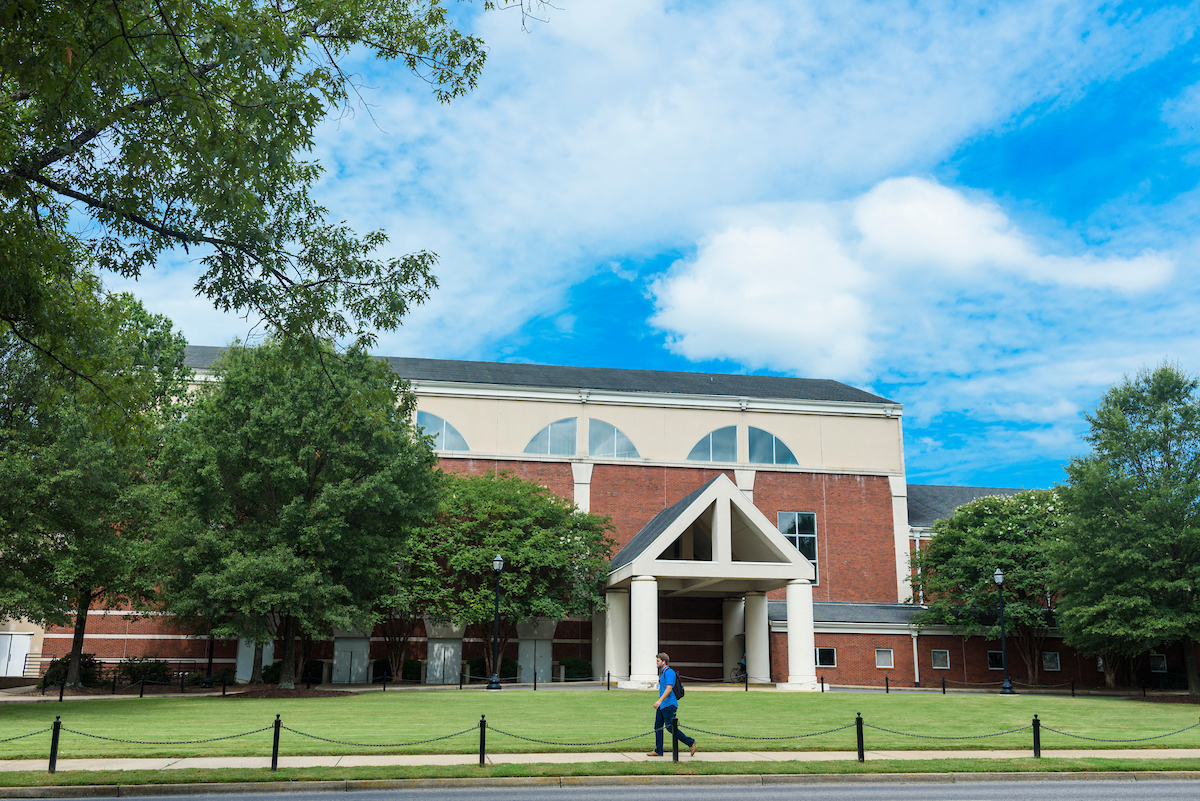
Moody Music Building
1986
The music education program is housed in the Frank Moody Music Building. The building contains both the choral music and the instrumental music programs.
The School of Music had long outgrown its quarters in the Music and Speech Building when plans to erect a large new building were first envisioned. It was originally intended to be built in the northwestern section of campus as part of the liberal arts grouping of buildings proposed by the 1961 Greater University Development Plan. With the acquisition of land on the east side of campus in the 1970s, a new site was selected and construction was begun on the building in 1986.
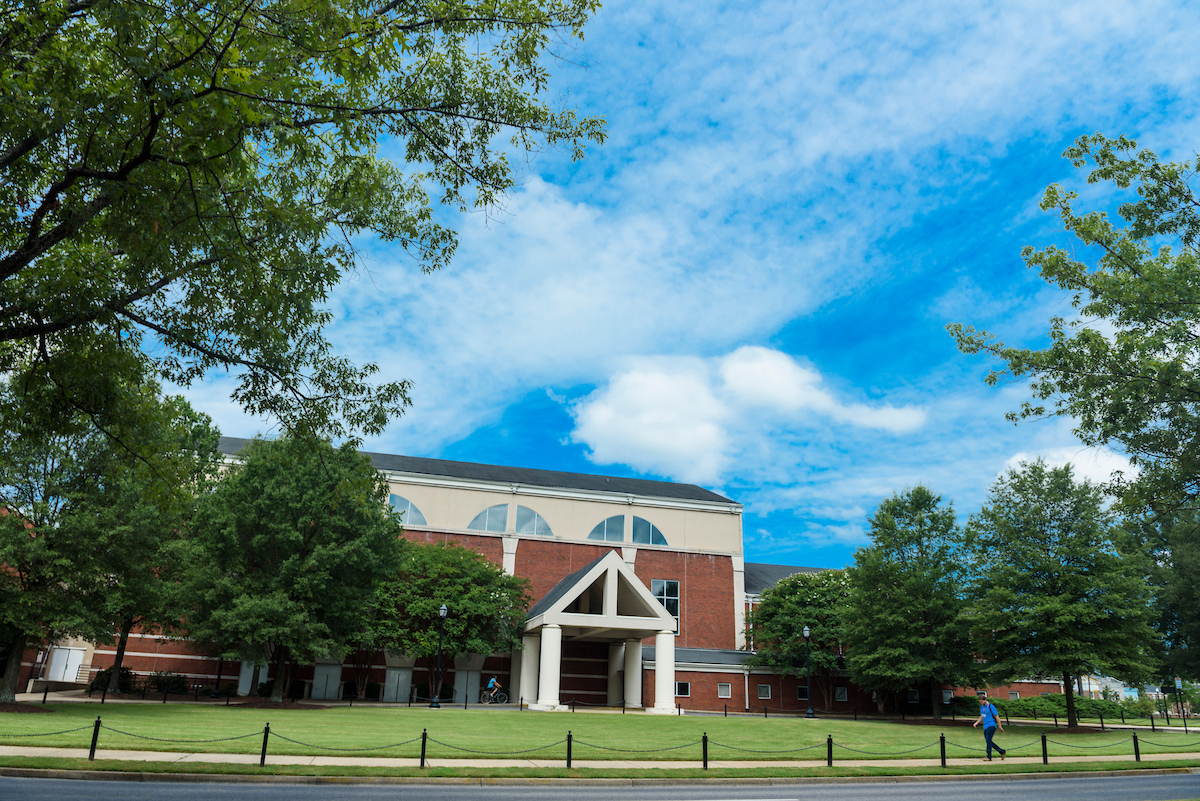
1986
The Frank Moody Music Building is named after a prominent Tuscaloosa banker and benefactor of the University. Woollen, Molzan and Partners of Indianapolis, and Fitts and White Associates of Tuscaloosa were the architects. A nationally known acoustic consultant, Lawrence Kirkegaard, assisted. The unusual design is a departure from the traditional Classical Revival style of the central campus and from the modern style of the Ferguson Center and the Law Center. The architects used the victorian campus buildings as their source of inspiration and freely interpreted such elements as steeply pitched gables, unusual window shapes, and Victorian asymmetry.
The building’s showpiece, however, is a 1,000-seat concert hall patterned after the home of the Vienna Philharmonic.
1987
The Innovative Leadership Program, a principal preparation program, is initiated with a grant from the Danforth Foundation. The grant is designed to help The University collaborate with local school districts to develop a program which will produce visionary principals capable of leading schools with diverse student populations.
1992
The Clinical Master Teacher Program (CMT) is created. The CMT trains and empowers outstanding regular and special education public school teachers to fulfill the traditional roles of both the campus-based college supervisor and the public school-based cooperating teacher.
1994
The Multiple Abilities Program (MAP) is implemented MAP combines three certifications [Mild Learning and Behavior Disorders (K-6), Elementary Education (1-6), and Early Childhood Education (K-3)] into one Class B certification. The program is designed to prepare educators to teach students with average and above average abilities as well as those with mild learning or behavior disorders.
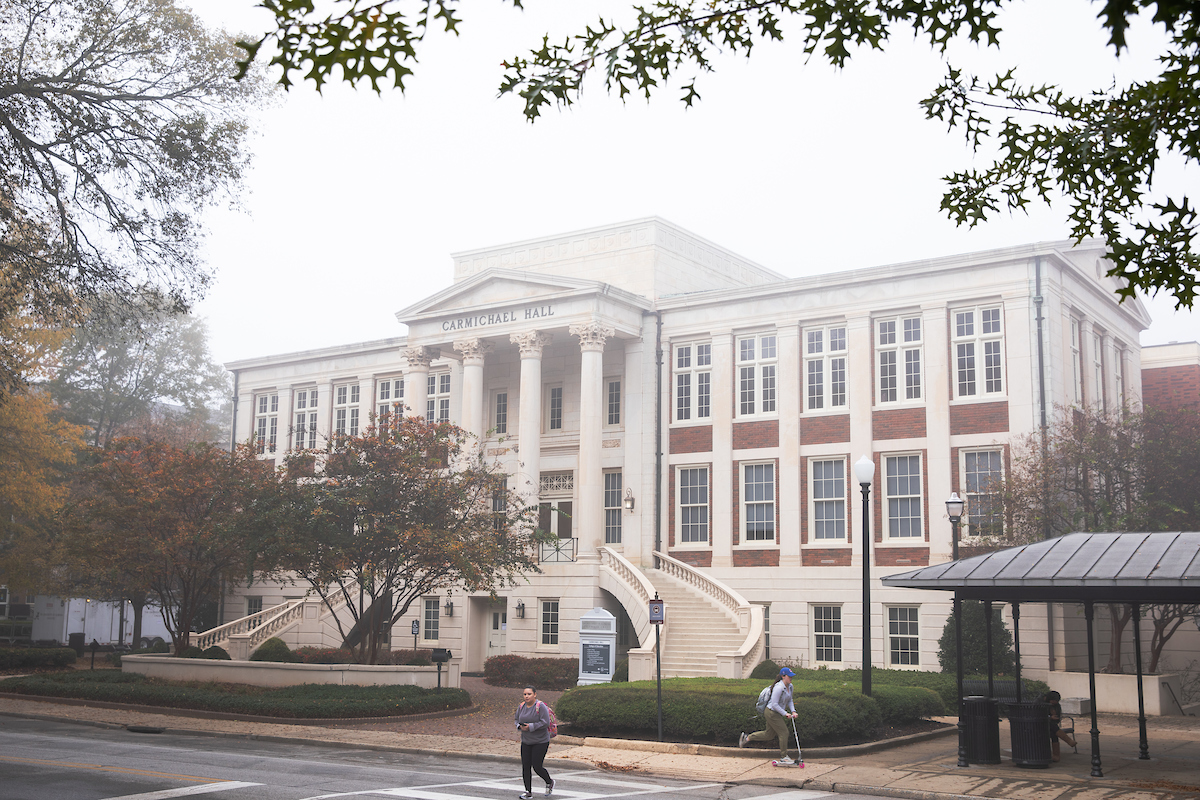
Carmichael Hall
1995
The first Amelia Gayle Gorgas Library (now Carmichael Hall), built in 1925, was intended to serve as a temporary library until funds to erect a larger structure could be secured. It was then to be converted into an administration building. Initially, only the lower floor was used for administration. The building is similar in scale and design to Nott Hall, directly across the Quadrangle.

The upper two floors housed the library until the completion of the Amelia Gayle Gorgas Library. It had a capacity of about 60,000 books in stacks kept closed to students. The general reading room, containing current, occupied the whole front section of the third.
After the library was moved to its new quarters in 1940, the building served as the administrative headquarters for the University until the construction of Rose Administration Bulding in 1969. In 1971 the old building was renamed Carmichael Hall in honor of President Oliver Cromwell Carmichael.
Following extensive renovations in 1995, Carmichael Hall became the home of the College Dean’s office on the second floor. The Financial Affairs office, the College and Alumni Relations office, the Capstone Education Society, and the Office of Development are also housed on the second floor. The programs in educational and school psychology and educational research are located on the third floor, and the Office of Student Services, the Office of Clinical Experiences, and the Office of Research and Service are located on the first floor of this three-storied building.
1997
The Special Education program develops the Collaborative Teacher Program to conform to new SDE certification requirements. This program, the first of its kind to be approved in Alabama, prepares special educators to work with other teachers and community agency representatives to provide an appropriate education for students with cognitive, behavioral, physical and/or multiple disabilities.
1999
With a goal of achieving 100% literacy among Alabama public school students, the Alabama State Department of Education initiated the Alabama Reading Initiative training. Since the summer of 2000 the Regional In-Service Centers have administered all Alabama Reading Initiative summer training programs.
2000
The Alabama Community College Leadership Academy is developed to prepare community college leaders by enhancing their leadership and management skills for an environment of change and to promote active partnership within postsecondary education.
2002
The University of Alabama Superintendents’ Academy (UASA) is a collaborative effort between the Instructional Services Division of the Alabama State Department of Education and The University of Alabama, College of Education’s Department of Educational Leadership, Policy and Technology Studies and Education Policy Center.
Founded by Dr. Kagendo Mutua and Dr. Marcie Rock, CrossingPoints is a collaboration between the Special Education & Multiple Abilities Department and the Tuscaloosa City and County School Systems. The purpose of CrossingPoints is to provide transition services for students with disabilities ages 18-21. Students participating in CrossingPoints receive hands on instructions in vocational/employment aspects of transition during their job placement and specially selected or assigned job sites at the University of Alabama.
2003
The University of Alabama Wheelchair Athletics program was founded in 2003 by Drs. Brent Hardin and Margaret Stran. The program started with a women’s wheelchair basketball team and added a men’s team in 2006. Both teams have enjoyed the support of the Alabama administration, students and faculty including UA President Robert Witt and Alabama has become one of the leaders in the collegiate wheelchair athletics in just a few short years. In 2009, the women’s team was named national champion.
2006
The inaugural class of the Executive Ed.D. program began its program. This innovative model is designed for experienced professionals who have served in high-level positions in higher education and related industries.
2007
Graves Hall reopens after a major renovation that took it down to the bones of the building. This major renovation of the building, the first since it was built in 1929, will enable a new generation of teachers to have the best learning environment in which to acquire the art and skills necessary to become outstanding educators. President Robert Witt stated, The University of Alabama does not have a higher priority than training the next generation of teachers.”

Tom Barnes Hall
1995
In 2014, the College of Education acquired the Tom Barnes Hall after the University purchased the Bryce campus.
Tom Barnes was an aide to Alabama Sen. Richard C. Shelby. He came to Washington in 1990 and rose from an intern to a full staff member for Mr. Shelby in just six months. Barnes was murdered in 1992. He was 25.

Barnes was a “young man who came to Washington filled with hopes of helping to make a better country… he had the ordinary desires and needs shared by so many of us: music, coffee, warm clothes for winter. Through his wallet, presented in evidence by the prosecution, [he] carried a quote from John Adams: “‘Teach your sons war and politics so that theirs might learn mathematics and medicine so that their children can study art, poetry, music and philosophy.’”
The UA In-Service Education Center, Multiple Abilities Program, CrossingPoints, and the Belser Parton Literacy Center are all now in the Tom Barnes Hall.

Hillard Building
2016
Since 2016, the Hillard Building houses the Alabama Behavior Support Office as well as parts of CrossingPoints.
The Alabama Positive Behavior Support Office is a statewide technical assistance and research agency that focuses on preventing challenging behavior, improving school climate and student outcomes, and supporting students at-risk for and with disabilities. This Office provides technical assistance through (1) initial and booster training in schoolwide positive behavior interventions and supports (PBIS), (2) Tier 2 PBIS training, (3) Tier 3 PBIS training, (4) three-tiered coaching and ongoing support, and (5) PBIS, discipline, and school climate data collection and analysis.

CrossingPoints is an on campus transition program at the University of Alabama in cooperation with the UA, Tuscaloosa City and County School System. This site provides information on our students, staff, how to volunteer or how to become one of CrossingPoints Jobsites, along with other information relevant to our program.

Capital Hall
2017
Capital Hall houses the educational neuroscience faculty and the Institute for Educational Neuroscience as well as Office of Evaluation Research and School Improvement.
The Institute for Educational Neuroscience includes the Center for the Study of Ethical Development, the Embodied Learning Design and Educational Neuroscience Lab, the Education & Cognitive Science Lab, the Neuromodulation Processes and Virtual Reality Lab, and the Social, Emotional and Educational Neuroscience Lab.

It is the mission of the Office of Evaluation Research and School Improvement to provide high quality evaluation services that will improve translation into practice. They provide comprehensive monitoring, evaluation, and measurement services to determine the impact of education, training, and community programs across the state and the nation to inform and improve decisions and policy.
Part of the Department of Special Education and Multiple Abilities is housed here including the early intervention program (EI@UA) as well as the Evidence-based International Early Intervention Office (EIEIO), the academic and administrative home of the Routines-Based Model (RBM).

Nall Gallery
2017
Acclaimed multi-medium artist and University of Alabama alumnus Fred “Nall” Hollis donated a collection of etchings and other works to the College. Hollis, known professionally as “Nall,” donated artwork valued at more than $540,000 to the UA College of Education, which is displayed in the Nall Gallery in the third-floor rotunda of Carmichael Hall. Nall served as artist-in-residence at UA in 2000 and helped bring Alabama’s arts community to national notoriety through the traveling exhibit – and book – “Alabama Art,” a collection of portraits of 12 Alabama artists and their works. Nall is currently based in Fairhope after spending a great part of his career in France, where his Nature Art and Life League (N.A.L.L.) offered apprenticeships to international students, some from UA.

Nall, born and raised in Troy, earned a bachelor’s degree in art at UA in 1970. A year later, he moved to Paris, France to study at its Ecole National des Beaux Arts (School of Fine Arts). He’d travel across Europe, the Middle East, Asia and Mexico, learning different mediums from the likes of Spanish surrealist artist Salvador Dali, who influenced his etchings, some of which will be on display at UA. Nall developed a reputation for producing art in many mediums, particularly mosaics, sculpture and line engravings. He’s also created porcelain designs for Haviland, Royal Limoges, Monaco and Tunisian porcelain, and he makes tapestries and opera set and costume designs. His artwork has been displayed in art museums across the United States and internationally in Monaco and the Vatican, among others.
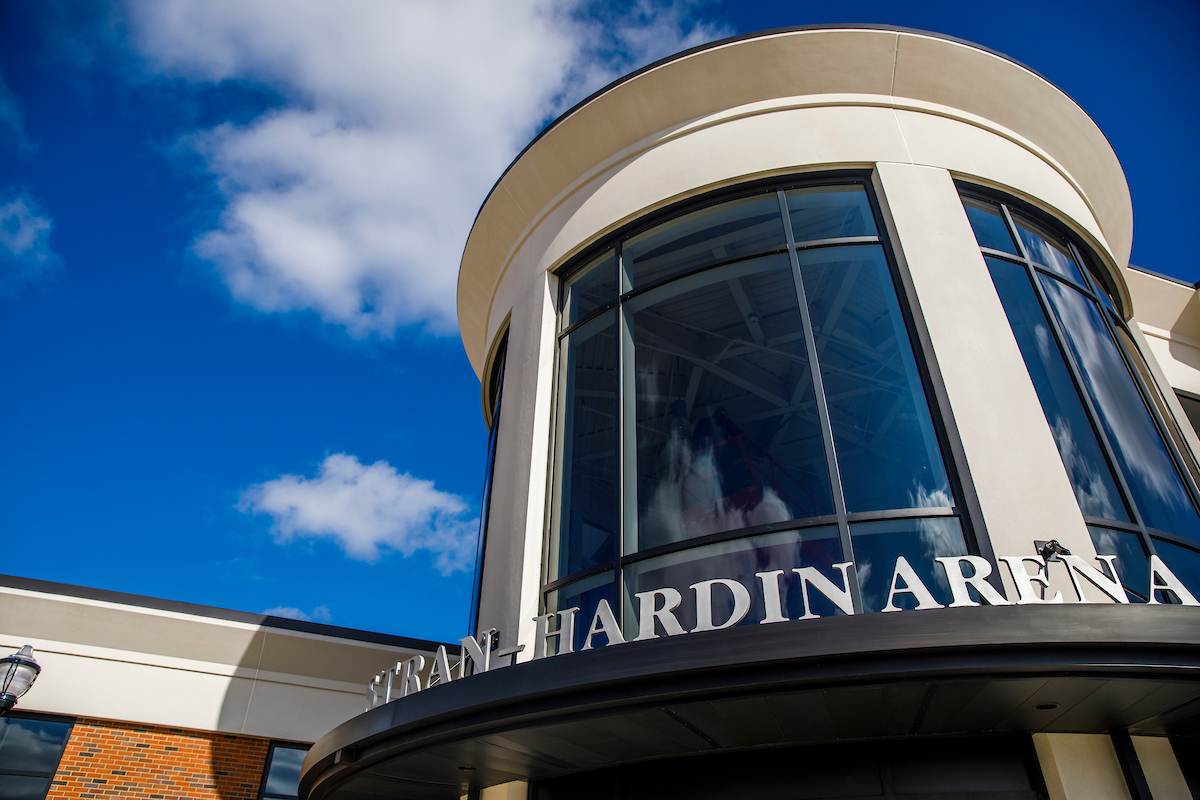
Stran-Hardin Arena
2018
Stran-Hardin Arena, the $10 million multi-purpose facility that houses the Alabama Adapted Athletics program, is named for Drs. Brent Hardin and Margaret Stran, the founders of the program. It includes a NCAA regulation game venue for wheelchair basketball, locker rooms, an athletic training room, a strength and conditioning room, team meeting rooms and study halls. Stran-Hardin Arena is the first of its kind on a college campus in the U.S. and is located along the south façade of the UA Recreation Center, east of the main entrance.

Alabama Adapted Athletics began in 2003 with women’s wheelchair basketball. The program has since grown to include men’s basketball, wheelchair tennis, para-rowing, adapted golf, and para track and field and is home to 24 national championships overall.

Parker-Haun Tennis Facility
2021
Alabama Adapted Athletics officially opened the Parker-Haun Tennis Facility, the only collegiate tennis facility in the nation for adapted student-athletes, with a ribbon-cutting ceremony Oct. 1.
Named in recognition of a $500,000 gift from the Parker and Haun families, the new 3,835-square-foot tennis facility is located immediately adjacent to the student recreation courts managed by University Recreation. The space includes locker rooms, restrooms, a trainer’s room and offices for the coaching staff. In addition to the gift from the Parker and Haun families, the facility also received an additional $370,000 in gifts from 21 donors.

